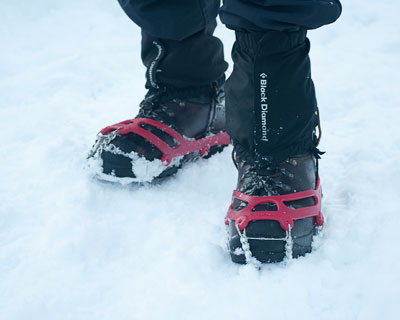I've been spending quite some time in the cold places of late. Well, ok, I seem to have a thing for cold places, and can't stay away from them. But when I was in Iceland this January, whilst getting out of the 4x4 I'd rented, I managed to fall straight onto my back because I'd slipped on some solid ice.
 Shooting in winter has this possibility - a lot. There is the occasional bit of ice, and sometimes it can be really slippy out there. So I was looking for something that would be useful while I'm out and about, but at the same time be quick and easy to put on. I also wanted something that I could pack away very compactly into my camera bag.
Shooting in winter has this possibility - a lot. There is the occasional bit of ice, and sometimes it can be really slippy out there. So I was looking for something that would be useful while I'm out and about, but at the same time be quick and easy to put on. I also wanted something that I could pack away very compactly into my camera bag.
I'm sometimes walking on thick snow, so the usual Petzl shoe crampons (designed for walking on pavements) are pretty useless. So too, it seems are Yak Tracks, as my photo friend found after losing them at Jokulsarlon beach in Iceland.
I settled on a pair of kahtoola microspikes. Fell runners use them - they're quick to slip onto your shoe / boot, and they are flexible enough to be scrunched up into a small ball and stored in your camera bag somewhere. I've used them in Norway this week and found them terrific for those bits where there was ice or compacted snow - on hill sides, beaches, roads, etc.
They do have a down side - unlike a proper crampon, they do not have an anti-ball plate. An anti ball plate is a rubber sole that pops any snow off the boot's surface, so that the spikes remain clear to make contact with the ground. The Kahtoola's aren't crampons, but a rubber mould that hugs the boot and has small spikes in the base - they're very effective for a terrain that is not hard-core. So I don't consider the lack of an anti-balling plate a bad thing - just something you need to be aware of.
I have a pair of Grivel G10 crampons at home. They're designed for the hills, and tough gradients - something I don't need for the bit of walking around on relatively flat ground whilst making photos. Crampons require a lot more time to put on your foot and strap on securely. They can also do a lot of damage to your leg if you're not familiar with using them. The spikes on crampons are intended for heavy duty mountain climbing and steep gradients. Unlike the kahtoola's, they're a much more serious proposition and not a good idea for just the occasional bit of stability when encountering a bit of compacted snow. So if you're on the lookout for something to stop you slipping in thick snow and ice, also to help you get into icy streams or rivers and keep your footing, then the kahtoola microspikes are my recommendation.
Regarding boot wear, I should let you know that I prefer tradtional leather walking boots. I've used Scarpa M3's for years. I have two sets of them because I like them so much. So long as I prime them with Sno-Seal every now and then (stick them in the oven first to heat up the leather as it helps the sno-seal sink in), they are a robust, comfortable, waterproof boot for walking around in boggy terrain (something I tend to do a lot of these days).
I'm not a fan of gore-tex, and if I'm expecting to have my boots submerged into a foot of brackish water, then it would have to be a solid, leather boot like the Scarpa's. The sole is also very solid, so I feel very secure when walking around on rocks and other unstable terrain.
ps. yes, those are my fine ankles you see in the shot above!
